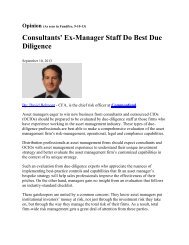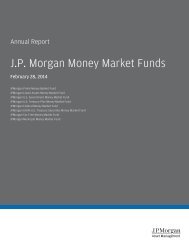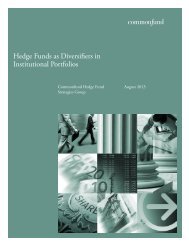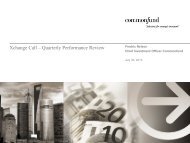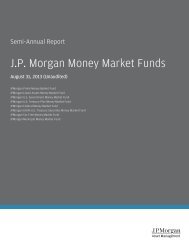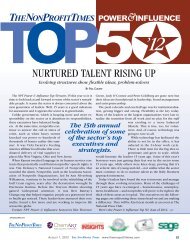The Investment Policy Statement - Commonfund
The Investment Policy Statement - Commonfund
The Investment Policy Statement - Commonfund
You also want an ePaper? Increase the reach of your titles
YUMPU automatically turns print PDFs into web optimized ePapers that Google loves.
<strong>The</strong> two most frequently used approaches to rebalancing are those in which the<br />
process is conducted a certain number of times a year (calendar-based) and those in<br />
which rebalancing takes place whenever the targets or ranges in the asset allocation<br />
table have been exceeded (target/range-based). In the former the portfolio may be<br />
rebalanced monthly, quarterly, annually or at some other time interval; in the NCSE<br />
and Benchmarks research, around one-fourth of institutions report rebalancing<br />
quarterly. In the latter, as noted above, the rebalancing is triggered when the ranges<br />
or bands are exceeded; around three-fourths to four-fifths of survey participants<br />
report using this method, probably in coordination with one of the calendar-based<br />
alternatives. Rebalancing may also be triggered in response to major gifts or other<br />
changes in cash flow, in order to ensure that the portfolio remains within its permitted<br />
asset allocation ranges. Whichever method is used, it is important that the rebalancing<br />
process itself not become the subject of subsequent debate (apart, that is, from the<br />
annual review of the investment policy). If it is regarded as optional, the board<br />
or committee may be tempted to engage in market timing and the policy will lose<br />
its effectiveness.<br />
<strong>The</strong> investment policy statement should also contain descriptions of permitted and<br />
prohibited asset classes, investment strategies and instruments. <strong>The</strong> purpose of this list<br />
is to enable the board or committee to focus on the role of the various strategies in the<br />
context of the portfolio and its goals. To this end, it should include not only strategies<br />
that the institution intends to use immediately, but those that it may use in the future.<br />
For example, the statement might permit certain classes of alternative investments<br />
while assigning them a weighting of zero in the current portfolio. Going through the<br />
work of considering and describing their potential role and advantages enables the<br />
board or committee to be prepared for the time when a place will be made for them<br />
in the portfolio.<br />
©2011 COMMONFUND 9



